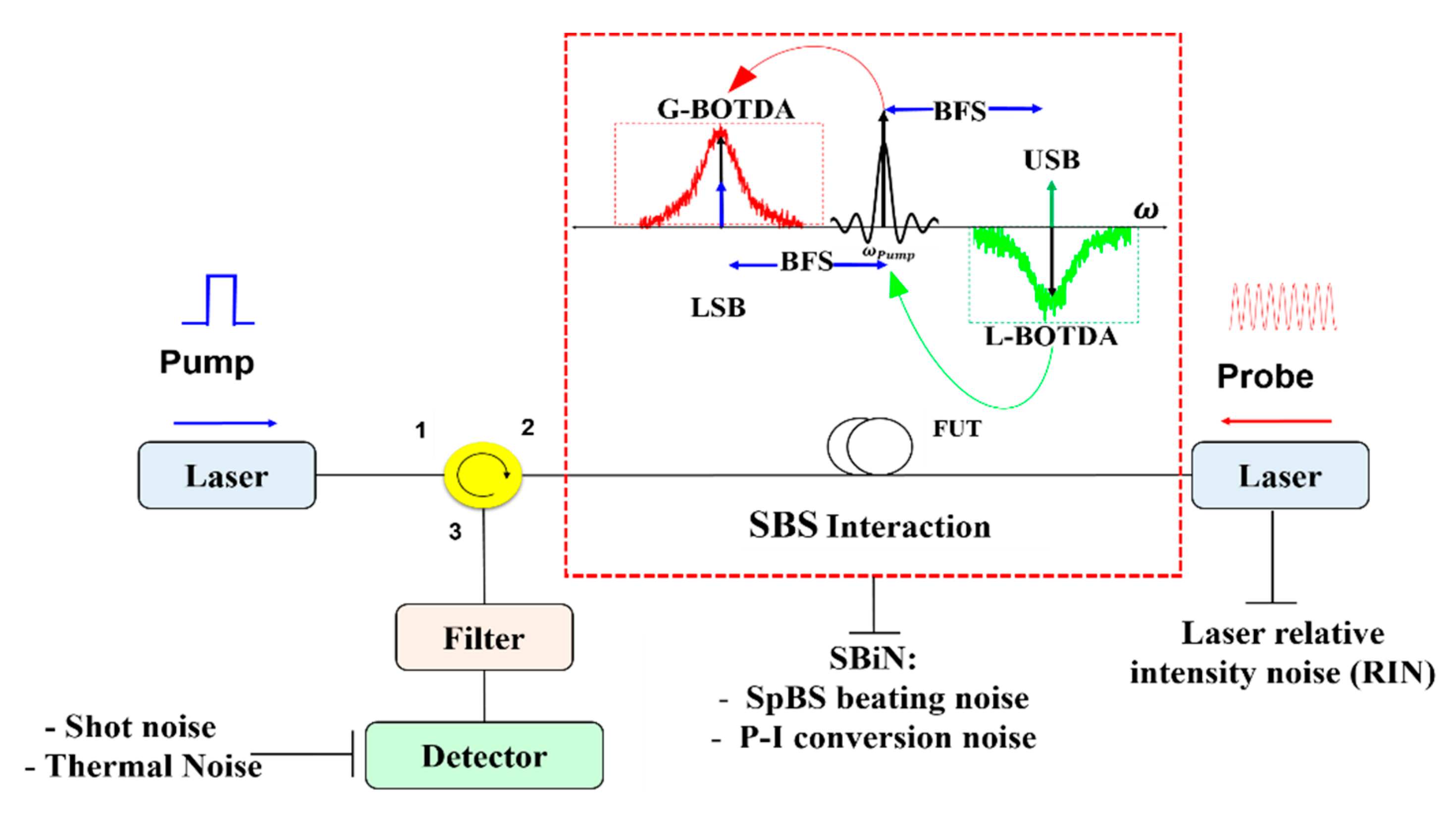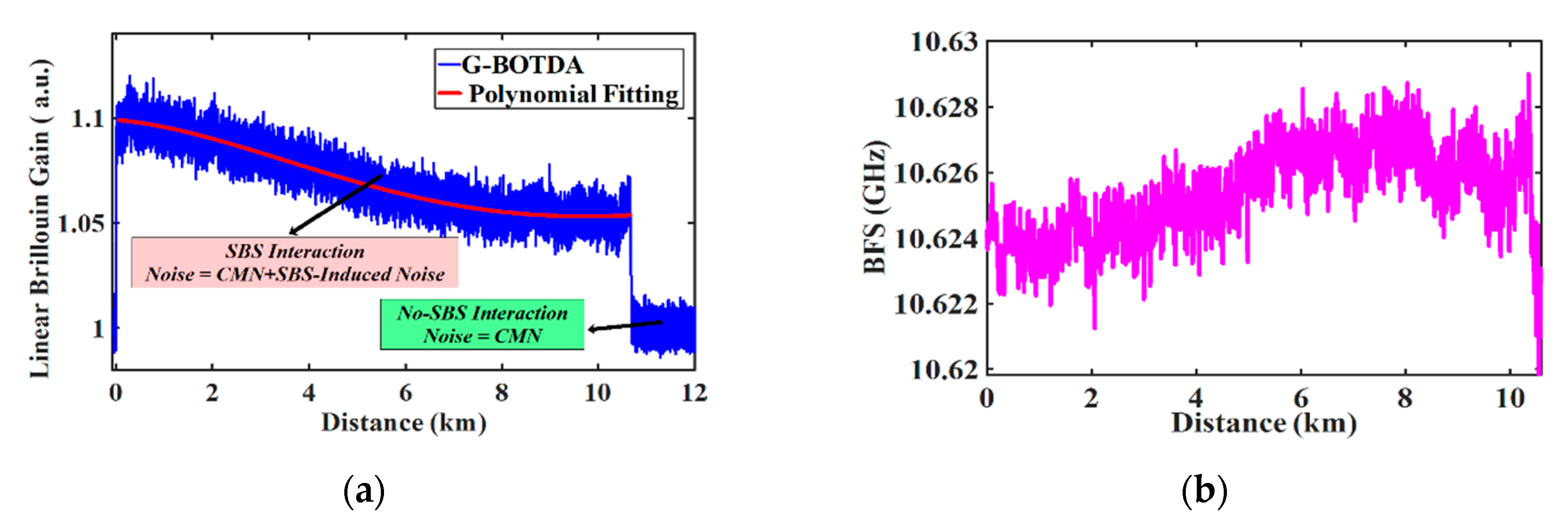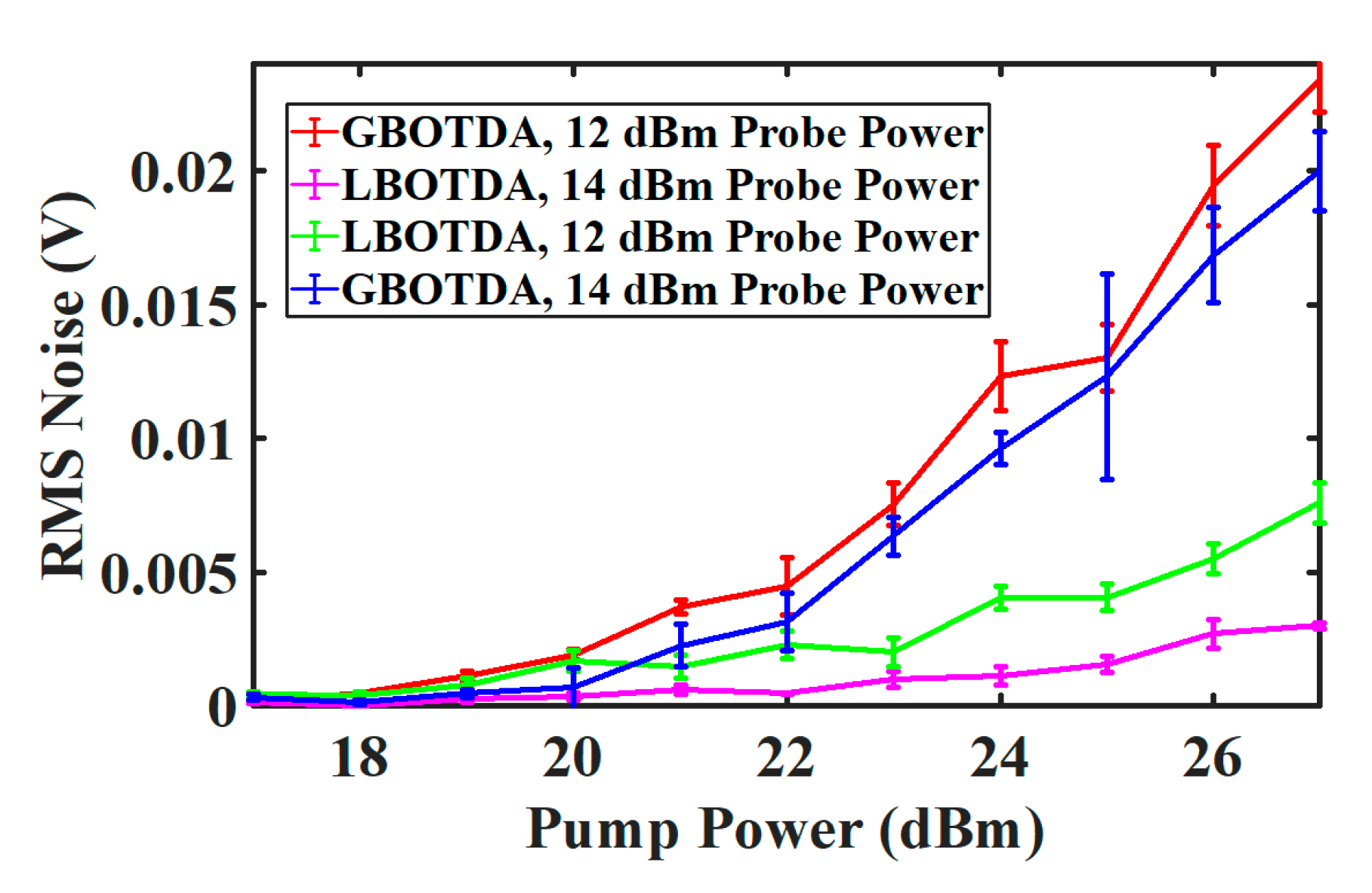Characterization of the Noise Induced by Stimulated Brillouin Scattering in Distributed Sensing
Abstract
1. Introduction
2. Noise Sources in BOTDA
3. Theoretical Model
3.1. Probe-SpBS Beating Noise
3.2. Phase-to-Intensity Conversion Noise
3.3. Simulation Model
4. Experiment
5. Results and Discussion
5.1. SBS-Induced Noise Calculation Method
5.2. Results
5.3. Noise Dependence on Pump and Probe Power
5.4. Spatial Resolution Dependency
5.5. Noise Measurement in Frequency Domain
6. Conclusions
Author Contributions
Funding
Acknowledgments
Conflicts of Interest
Appendix A
References
- Bao, X.; Chen, L. Recent progress in Brillouin scattering based fiber sensors. Sensors 2011, 11, 4152–4187. [Google Scholar] [CrossRef]
- Horiguchi, T.; Shimizu, K.; Kurashima, T.; Tateda, M.; Koyamada, Y. Development of a distributed sensing technique using Brillouin scattering. J. Light. Technol. 1995, 13, 1296–1302. [Google Scholar] [CrossRef]
- Yeniay, A.; Delavaux, J.M.; Toulouse, J. Spontaneous and stimulated Brillouin scattering gain spectra in optical fibers. J. Light. Technol. 2002, 20, 1425–1432. [Google Scholar] [CrossRef]
- Agrawal, G.P. Nonlinear Fiber Optics, 5th ed.; Elsvier: Amsterdam, The Netherlands, 2013. [Google Scholar]
- Niklès, M.; Thevenaz, L.; Robert, P.A. Brillouin gain spectrum characterization in single-mode optical fibers. J. Light. Technol. 1997, 15, 1842–1851. [Google Scholar] [CrossRef]
- Motil, A.; Bergman, A.; Tur, M. State of the art of Brillouin fiber-optic distributed sensing. Opt. Laser Technol. 2016, 78, 81–103. [Google Scholar] [CrossRef]
- Feng, C.; Kadum, J.E.; Schneider, T. The State-of-the-Art of Brillouin Distributed Fiber Sensing. In Brillouin Distributed and Fiber-Bragg-Grating-Based Fiber Sensing—Principle, Measurement and Applications; IntechOpen: London, UK, 2019. [Google Scholar]
- Soto, M.A.; Thévenaz, L. Modeling and evaluating the performance of Brillouin distributed optical fiber sensors. Opt. Express 2013, 21, 31347–31366. [Google Scholar] [CrossRef]
- Rogers, A.J. Distributed optical-fibre sensing. Meas. Sci. Technol. 1999, 10, R75–R99. [Google Scholar] [CrossRef]
- Alem, M.; Soto, M.A.; Thévenaz, L. Analytical model and experimental verification of the critical power for modulation instability in optical fibers. Opt. Express 2015, 23, 29514–29532. [Google Scholar] [CrossRef] [PubMed]
- Thévenaz, L.; Mafang, S.F.; Lin, J. Effect of pulse depletion in a Brillouin optical time-domain analysis system. Opt. Express 2013, 21, 14017–14035. [Google Scholar] [CrossRef] [PubMed]
- Rodriguez-Barrios, F.; Martin-Lopez, S.; Carrasco-Sanz, A.; Corredera, P.; Ania-Castanon, J.D.; Thevenaz, L.; Gonzalez-Herraez, M. Distributed Brillouin Fiber Sensor Assisted by First-Order Raman Amplification. J. Light. Technol. 2010, 28, 2162–2172. [Google Scholar] [CrossRef]
- Angulo-Vinuesa, X.; Martin-Lopez, S.; Nuno, J.; Corredera, P.; Ania-Castanon, J.D.; Thevenaz, L.; Gonzalez-Herraez, M. Raman assisted brillouin distributed temperature sensor over 100 km featuring 2 m resolution and 1.2 °C uncertainty. J. Light. Technol. 2012, 30, 1060–1065. [Google Scholar] [CrossRef]
- Soto, M.A.; Bolognini, G.; Di Pasquale, F. Long-range simplex-coded BOTDA sensor over 120 km distance employing optical preamplification. Opt. Lett. 2011, 36, 232–234. [Google Scholar] [CrossRef] [PubMed]
- Zornoza, A.; Sagues, M.; Loayssa, A. Self-heterodyne detection for SNR improvement and distributed phase-shift measurements in BOTDA. J. Light. Technol. 2012, 30, 1066–1072. [Google Scholar] [CrossRef]
- Peled, Y.; Motil, A.; Yaron, L.; Tur, M. Slope-assisted fast distributed sensing in optical fibers with arbitrary Brillouin profile. Opt. Express 2011, 19, 19845–19854. [Google Scholar] [CrossRef] [PubMed]
- Peled, Y.; Motil, A.; Tur, M. Fast Brillouin optical time domain analysis for dynamic sensing. Opt. Express 2012, 20, 8584–8591. [Google Scholar] [CrossRef]
- Farahani, M.A.; Wylie, M.T.; Castillo-Guerra, E.; Colpitts, B.G. Reduction in the number of averages required in BOTDA sensors using wavelet denoising techniques. J. Light. Technol. 2012, 30, 1134–1142. [Google Scholar] [CrossRef]
- Soto, M.A.; Ramírez, J.A.; Thévenaz, L. Intensifying the response of distributed optical fibre sensors using 2D and 3D image restoration. Nat. Commun. 2016, 7, 1–11. [Google Scholar] [CrossRef]
- Kadum, J.E.; Feng, C.; Preussler, S.; Schneider, T. Improvement of the measurement accuracy of distributed Brillouin sensing via radio frequency filtering. In Proceedings of the Seventh European Workshop on Optical Fibre Sensors, Limassol, Cyprus, 1–5 October 2019; Volume 11199, p. 111991R. [Google Scholar]
- Denisov, A.; Soto, M.A.; Thévenaz, L. Going beyond 1,000,000 resolved points in a Brillouin distributed fiber sensor: Theoretical analysis and experimental demonstration. Light Sci. Appl. 2016, 5, e16074. [Google Scholar] [CrossRef]
- Angulo-Vinuesa, X.; Dominguez-Lopez, A.; Lopez-Gil, A.; Ania-Castañón, J.D.; Martin-Lopez, S.; Gonzalez-Herraez, M. Limits of BOTDA range extension techniques. IEEE Sens. 2015, 16, 3387–3395. [Google Scholar] [CrossRef]
- Domínguez-López, A.; López-Gil, A.; Martín-López, S.; González-Herráez, M. Signal-to-noise ratio improvement in BOTDA using balanced detection. IEEE Photonics Technol. Lett. 2014, 26, 338–341. [Google Scholar] [CrossRef]
- Urricelqui, J.; Soto, M.A.; Thévenaz, L. Sources of noise in Brillouin optical time-domain analyzers. In Proceedings of the 24th International Conference on Optical Fibre Sensors, Curitiba, Brazil, 28 September–2 October 2015; Volume 9634, p. 963434. [Google Scholar]
- Feng, C.; Preussler, S.; Kadum, J.E.; Schneider, T. Measurement Accuracy Enhancement via Radio Frequency Filtering in Distributed Brillouin Sensing. Sensors 2019, 19, 2878. [Google Scholar] [CrossRef] [PubMed]
- Shlomovits, O.; Langer, T.; Tur, M. The effect of source phase noise on stimulated brillouin amplification. J. Light. Technol. 2015, 33, 2639–2645. [Google Scholar] [CrossRef]
- Minardo, A.; Bernini, R.; Zeni, L. Analysis of SNR penalty in Brillouin optical time-domain analysis sensors induced by laser source phase noise. J. Opt. 2016, 18, 025601. [Google Scholar] [CrossRef]
- Feng, C.; Preussler, S.; Schneider, T. The influence of dispersion on stimulated-brillouin-scattering-based microwave photonic notch filters. J. Light. Technol. 2018, 36, 5145–5151. [Google Scholar] [CrossRef]
- Schneider, T.; Feng, C.; Preussler, S. Dispersion engineering with stimulated Brillouin scattering and applications. In Proceedings of the Steep Dispersion Engineering and Opto-Atomic Precision Metrology XI, San Francisco, CA, USA, 22 February 2018; Volume 10548, p. 105480U. [Google Scholar]
- Feng, C.; Preussler, S.; Schneider, T. Sharp tunable and additional noise-free optical filter based on Brillouin losses. Photonics Res. 2018, 6, 132–137. [Google Scholar] [CrossRef]
- Choi, M.; Mayorga, I.C.; Preussler, S.; Schneider, T. Investigation of gain dependent relative intensity noise in fiber brillouin amplification. J. Light. Technol. 2016, 34, 3930–3936. [Google Scholar] [CrossRef]
- Boyd, R. Nonlinear Optics; Academic Press: Cambridge, MA, USA, 2008. [Google Scholar]
- Boyd, R.W.; Rzazewski, K.; Narum, P. Noise initiation of stimulated Brillouin scattering. Phys. Rev. A 1990, 42, 5514–5521. [Google Scholar] [CrossRef] [PubMed]
- Thévenaz, L. Advanced Fiber Optics: Concepts and Technology; EPFL Press: Lausanne, Switzerland, 2011. [Google Scholar]
- Minardo, A.; Bernini, R.; Zeni, L. A simple technique for reducing pump depletion in long-range distributed brillouin fiber sensors. IEEE Sens. J. 2009, 9, 633–634. [Google Scholar] [CrossRef]
- Feng, C.; Lu, X.; Preussler, S.; Schneider, T. Gain spectrum engineering in distributed Brillouin fiber sensors. J. Light. Technol. 2019, 37, 5231–5237. [Google Scholar] [CrossRef]
- Wiatrek, A.; Preussler, S.; Jamshidi, K.; Schneider, T. Frequency domain aperture for the gain bandwidth reduction of stimulated Brillouin scattering. Opt. Lett. 2012, 37, 930–932. [Google Scholar] [CrossRef]
- Preussler, S.; Schneider, T. Bandwidth reduction in a multistage Brillouin system. Opt. Lett. 2012, 37, 4122–4124. [Google Scholar] [CrossRef] [PubMed]
- Preussler, S.; Wiatrek, A.; Jamshidi, K.; Schneider, T. Brillouin scattering gain bandwidth reduction down to 3.4 MHz. Opt. Express 2011, 19, 8565–8570. [Google Scholar] [CrossRef] [PubMed]
- Preussler, S.; Schneider, T. Stimulated Brillouin scattering gain bandwidth reduction and applications in microwave photonics and optical signal processing. Opt. Eng. 2015, 55, 031110. [Google Scholar] [CrossRef]
- Masoudi, A.; Newson, T.P. Contributed Review: Distributed optical fibre dynamic strain sensing. Rev. Sci. Instrum. 2016, 87, 011501. [Google Scholar] [CrossRef]
- Henry, C. Theory of the linewidth of semiconductor lasers. IEEE J. Quantum Electron. 1982, 18, 259–264. [Google Scholar] [CrossRef]
- Moslehi, B. Analysis of optical phase noise in fiber-optic systems employing a laser source with arbitrary coherence time. J. Light. Technol. 1986, 4, 1334–1351. [Google Scholar] [CrossRef]
- Zadok, A.; Eyal, A.; Tur, M. Stimulated Brillouin scattering slow light in optical fibers. Appl. Opt. 2011, 50, E38–E49. [Google Scholar] [CrossRef]
- Iribas, H.; Mariñelarena, J.; Feng, C.; Urricelqui, J.; Schneider, T.; Loayssa, A. Effects of pump pulse extinction ratio in Brillouin optical time-domain analysis sensors. Opt. Express 2017, 25, 27896–27911. [Google Scholar] [CrossRef]
- Feng, C.; Iribas, H.; Marinelaerña, J.; Schneider, T.; Loayssa, A. Detrimental Effects in Brillouin Distributed Sensors Caused by EDFA Transient. In Proceedings of the 2017 Conference on Lasers and Electro-Optics, San Jose, CA, USA, 14–19 May 2017; p. JTu5A.85. [Google Scholar]
- Soto, M.A.; Thévenaz, L. Towards 1,000,000 resolved points in a distributed optical fibre sensor. In Proceedings of the 23rd International Conference on Optical Fibre Sensors, Santander, Spain, 2 June 2014; Volume 9157, p. 9157C3. [Google Scholar]
- Kumar, S.; Deen, M.J. Fiber Optic Communications: Fundamentals and Applications; John Wiley: Hoboken, NJ, USA, 2014. [Google Scholar]









| Parameter | Value | Unit |
|---|---|---|
| Fiber length | 10.6 | km |
| Pump pulse width | 175 | ns |
| Pump power | 20 | dBm |
| Probe power | −14 | dBm |
| Photodiode responsively | 0.95 | A/W |
| Photodiode bandwidth | 1 | GHz |
| Laser linewidth | 2 | MHz |
| Laser RIN | −135 | dB/Hz |
| Parameter | Frequency Offset | Pump Power | Probe Power | Setup | Pulse Width | Result |
|---|---|---|---|---|---|---|
| CN | 10 MHz | 20 | −14 | Gain-based | 175 ns | V |
| CN | 10 MHz | 20 | −14 | Loss-based | 175 ns | V |
| SBiN | 10 MHz | 20 | −14 | Gain-based | 175 ns | V |
| SBiN | 0 MHz | 20 | −14 | Gain-based | 175 ns | V |
| SBiN | 10 MHz | 20 | −14 | Loss-based | 175 ns | V |
| SBiN | 0 MHz | 20 | −14 | Loss-based | 175 ns | V |
| SBiN | 0 MHz | 17 | −14 | Gain-based | 175 ns | V |
| SBiN | 0 MHz | 17 | −14 | Loss-based | 175 ns | V |
| SBiN | 0 MHz | 27 | −14 | Gain-based | 175 ns | V |
| SBiN | 0 MHz | 27 | −14 | Loss-based | 175 ns | V |
| *Noise ratio | Whole BGS | 20 | −14 | Gain-based | 175 ns | 1 |
| *Noise ratio | Whole BLS | 20 | −14 | Loss-based | 175 ns | 0.8 |
| *Noise ratio | Whole BGS | 20 | −14 | Gain-based | 100 ns | 0.5 |
| *Noise ratio | Whole BLS | 20 | −14 | Loss-based | 100 ns | 0.2 |
© 2020 by the authors. Licensee MDPI, Basel, Switzerland. This article is an open access article distributed under the terms and conditions of the Creative Commons Attribution (CC BY) license (http://creativecommons.org/licenses/by/4.0/).
Share and Cite
Kadum, J.E.; Feng, C.; Schneider, T. Characterization of the Noise Induced by Stimulated Brillouin Scattering in Distributed Sensing. Sensors 2020, 20, 4311. https://doi.org/10.3390/s20154311
Kadum JE, Feng C, Schneider T. Characterization of the Noise Induced by Stimulated Brillouin Scattering in Distributed Sensing. Sensors. 2020; 20(15):4311. https://doi.org/10.3390/s20154311
Chicago/Turabian StyleKadum, Jaffar Emad, Cheng Feng, and Thomas Schneider. 2020. "Characterization of the Noise Induced by Stimulated Brillouin Scattering in Distributed Sensing" Sensors 20, no. 15: 4311. https://doi.org/10.3390/s20154311
APA StyleKadum, J. E., Feng, C., & Schneider, T. (2020). Characterization of the Noise Induced by Stimulated Brillouin Scattering in Distributed Sensing. Sensors, 20(15), 4311. https://doi.org/10.3390/s20154311






